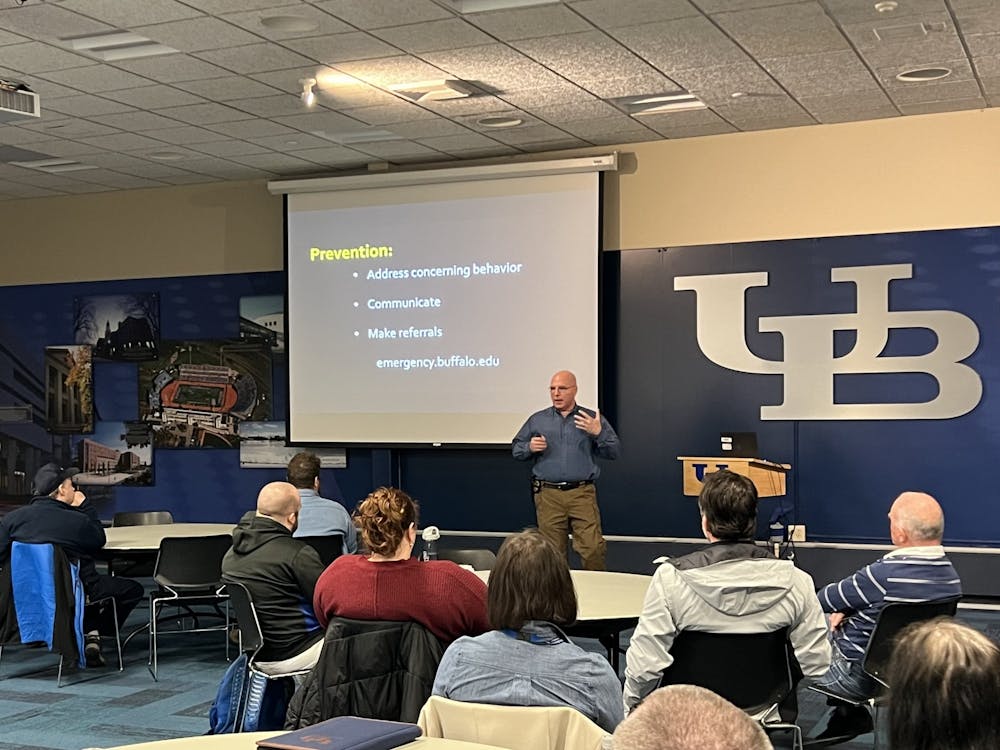University Police held a training session Wednesday that provided students, faculty and staff with information on what to do in the event of an active shooter on campus. UPD will be holding another session on Thursday at 4:30 p.m.
The training, instructed by Deputy Chief of Police Josh Sticht, provided tips on what to do before law enforcement arrives on campus in the event of an active shooter scenario.
According to data collected by the FBI, 18 out of 333 mass shootings from 2000-19 happened at institutions of higher education.
Sticht said the odds of being involved in an active shooter incident on campus is rare.
Although the statistics show this occurrence to be infrequent, Sticht stressed the importance of developing a personal escape and lockdown plan.
The “run, hide, fight” protocol was established by the U.S. Department of Homeland Security with the city of Houston, Texas and has been adopted nationwide.
That same protocol was used by the Michigan State University community during the shooting that took place on Feb. 13 which claimed the lives of three students.
In the event of an active shooter, UPD will send out a UB Alert text message and email to the university community. At that point, those on campus are advised to follow the “run, hide, fight” protocol.
The first option — run — is at the top of the priority list. If it is possible to evacuate, members of the community are urged to observe exits and alternate routes on campus to escape. Convincing other individuals to run is encouraged, but do not stay behind for those who refuse to leave.
People involved in an active shooting should run away from the sound of gunfire and get as far away from the scene as possible. Sticht says if one can see police responding to the scene, they are too close.
Once in a safe space, those involved are urged to call UPD directly at 716-645-2222.
If escaping is not an option, hiding is the next-best course of action.
Due to the relatively short durations of active shooting incidents — six minutes on average — the shooter is likely to keep moving if a door is locked or a room appears unoccupied.
Individuals should lock and barricade doors with heavy objects and remain completely quiet until an officer says it is safe to open the door. Sticht says individuals should wait for an officer to identify themselves via badge to verify that the situation is over.
The last resort in an active shooting situation is to confront and fight the shooter.
The protocol heavily encourages coordination and communication between those involved, as well as full commitment to fighting the shooter. The recent Lunar New Year shooting in California and the Club Q shooting in Colorado were provided as examples of individuals who successfully intervened to stop active shooters.
According to Sticht, New York State residents are within their rights to use any necessary force — even deadly — to defend themselves from an active shooter.
If shooting is still occuring when first responders arrive, they will not initially tend to the wounded; their priority is to neutralize the threat. Once the shooting is over, emergency personnel will evacuate victims and begin medical care.
People are encouraged to notify loved ones that they are safe in an effort to minimize traffic on communication lines and at the scene. Emergency responders will set up medical care and reunification centers in safe locations, such as UB’s apartment complexes, which feature open community areas.
Throughout the incident, the UB emergency alert page will be updated with new information as it arrives. UPD also encouraged downloading the Guardian App for emergency communication and notification.
Sticht provided additional resources for students and faculty to report a UB community member who demonstrates concerning activity.
The UB Students of Concern team was established to “proactively identify, assess, and offer coordinated institutional response,” assessing referred students for their potential risk to the campus and community.
Anyone can report concerning behavior to the Dean of Students or UPD.
Kiana Hodge is a news editor and can be reached at kiana.hodge@ubspectrum.com
Ryan Tantalo is the senior sports editor and can be reached at ryan.tantalo@ubspectrum.com

Ryan Tantalo is the managing editor of The Spectrum. He previously served as senior sports editor. Outside of the newsroom, Ryan spends his time announcing college hockey games, golfing, skiing and reading.





